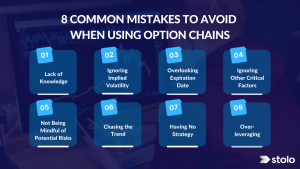Mistakes are bound to happen while trading. However, keeping yourself updated on them can reduce your chances of making the same mistakes. Options trading is a risk-reward trade approach. If you want to make some winning trades, this article is for you. You must know these 8 mistakes to avoid when using option chains in your trading to huge bag profits.
What are Option Chains?
An option chain is a list of all the open option contracts for a specific stock or other underlying assets. The strike price, expiration date, and current bid and ask prices for each option contract are all displayed in option chains.
Options traders use option chains to choose which options contracts to trade and evaluate the possible risk and profit of a deal. Making educated decisions about buying or selling options contracts can also be partially determined by option chains.
8 Common Mistakes To Avoid When Using Option Chains
Here are 8 common mistakes to avoid when using option chains while trading options:
- Lack of Knowledge
- Ignoring Implied Volatility
- Overlooking Expiration Date
- Ignoring Other Critical Factors
- Not Being Mindful of Potential Risks
- Chasing the Trend
- Having No Strategy
- Over-leveraging

1. Lack of Knowledge
Staring before educating yourself is one of the most common mistakes to avoid when using option chains. Understanding keywords and ideas like strike price, expiry date, and implied volatility is crucial before you begin trading options. Options trading may be complicated, and failing to comprehend keywords and ideas can result in costly errors. But starting strong with good foundational knowledge can benefit all your trades.
2. Ignoring Implied Volatility
A statistical measure of an underlying asset’s anticipated volatility, such as a stock or an index, is called implied volatility. The price of the options contracts on the underlying asset serves as its basis. Simply put, implied volatility is a projection of the asset’s future volatility based on the price of its options. Options traders utilise implied volatility to forecast an underlying asset’s price movement over an extended period. The projected price movement increases with implied volatility and vice versa.
Implicit volatility is an important element when trading options, as it could significantly affect the option’s price. Traders often ignore Implied volatility, which can lead to poor trades.
3. Overlooking Expiration Date
An important factor in options trading is the expiration date. When trading options, the expiration date must be considered because it might affect the option’s price and possible profit or loss. Options that are getting near expiration are more susceptible to fluctuations in the underlying stock price and may have less time to make a profit. Using automated trade features can aid in escaping this ignorance.
4. Ignoring Other Critical Factors
Interest rates, dividends, and economic events are a few more variables that might affect an option’s price and implied volatility. Before making a deal, consider these variables carefully because they have a big influence on the option’s price. One factor does not solely affect the options price. You need to consider the price simultaneously being affected by several factors.
5. Not Being Mindful of Potential Risks.
Another common mistake traders make is not being mindful of the risks. Options trading carries a significant amount of risk since they may expire worthless. It’s critical to be aware of the risks and to trade options only after thoroughly researching the underlying company and the market. Before investing in options trading, know the risk and reward possibilities. Option chains can help you to an extent, but that cannot be your sole analytical instrument.
6. Chasing the Trend
Utilise all critical analytical tools to choose your ideal stock to trade. It might be alluring to go with the flow or make popular trades, but it’s crucial to remember that factors besides stock price can affect option prices. Instead of just following the trend, conduct your study and place trades based on your insight.
7. Having No Strategy
Another common mistake young trades tend to make is to make a trade with no strategy in place. When trading options, it is important to have a well-defined plan and to stick to it, even when the market is volatile. Having a plan can help you avoid emotional and impulsive trades, which can be costly in the options market. Use a trading journal effectively to note down your strategies and their performance. These entries will give you exceptional inputs into your trading practices.
8. Over-leveraging
Avoiding over-leveraging should be a no-brainer, but young trades make these common mistakes when using option chains. Overleveraging or trading with too much leverage can be risky in the options market. Options traders frequently utilise margin to boost possible gains, but doing so also raises the risk of loss. To avoid losing money, only use a margin for trading that you can afford to lose.
Conclusion
Option chains on options trading platforms and financial websites are constantly updated to reflect the most recent market circumstances. You should know that the option price is affected by several variables, including implied volatility, interest rates, dividends, and economic events.
So, to start strong in options trading, one must know its risks and plausible mistakes to avoid when using option chain analysis tool. Make winning trades by simply avoiding these common mistakes. It is essential to do your research, have a well-defined plan, and understand the risks involved before making any options trade. Make sure to only trade with the amount of money you can afford to lose and diversify your options portfolio. Following these guidelines can increase your chances of success in the options market.

